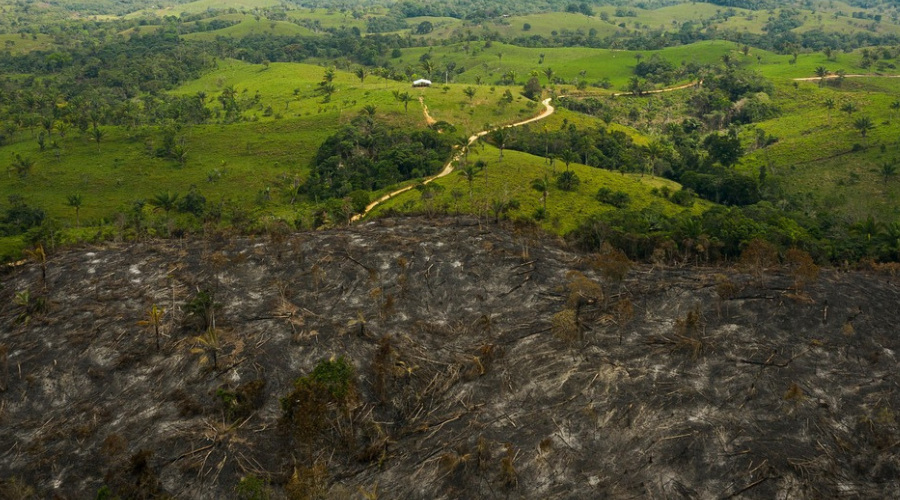
Speech: Integrating Nature-Based Solutions into France’s Water Security Strategy
1 August 2025
Pond ecosystems for a resilient future: working toward global recognition
4 August 2025By Mariana ALVES
In Brazil, the share of emissions is different from that of the rest of the world. On a global scale, fossil fuels, such as coal, oil, and gas, are responsible for over 75% of global greenhouse gas emissions. The case is different for the Latin American country. The energy sector was responsible for 18% of Brazil’s total emissions in 2023, while the main emitting sector, land use changes, accounted for more than double it, with 46% (SEEG, 2024). Land use change emissions are mainly based on deforestation (Azevedo et al., 2018), so deforestation was responsible for almost half of Brazil’s emissions in 2023.
Still looking at the Greenhouse Gas Emissions and Removals Estimating System (SEEG) data, Brazil emitted 2.3 billion tons of carbon dioxide equivalent in 2023, a 12% reduction compared to 2022. The reduction was driven by a 24% drop in emissions from deforestation, the result of the current government’s resumption of policies to combat devastation in the Amazon.
Brazil, under Luiz Inacio Lula da Silva’s government, has strengthened the environmental entities, notably the Brazilian Institute for the Environment and Renewable Natural Resources (Ibama), and resumed the main program responsible for the fall in deforestation: the Prevention and Control of Deforestation in the Legal Amazon (PPCDAm) (Van Voorhis, 2024). The PPCDAM is regarded as one of the most important factors in fighting deforestation in the Amazon, provoking a decrease in devastation of 80% from 2004 to 2014 (Moulin, 2023).
As a result, deforestation has fallen since the start of the Lula government, which is a stark contrast when compared to the previous administration’s handling of the forest. Lula knows the importance of fighting deforestation. In one of his first speeches of his third term in Presidency, at COP27, he declared the government’s commitment to end deforestation by 2030.
If this pledge is fulfilled, Brazil would likely meet its climate goals. Projections from Observatório do Clima (2024) show that if deforestation effectively reaches zero, Brazil could meet its NDC — even if emissions from other sectors remain at current levels. Observatório do Clima’s analysis is based on methodologies aligned with IPCC science and the Climate Equity Reference Project, which estimates Brazil’s fair share of the 1.5°C pathway.
Despite the government’s zero deforestation by 2030 pledge, Brazil’s recently submitted official NDC allows for continued legal deforestation through a “zero deforestation with compensation” approach (Brazil, 2024). This mechanism permits deforestation to continue beyond 2030, as long as it is compensated for by reforestation elsewhere. As a result, the NDC leaves room for high levels of forest loss and associated emissions — even in its most ambitious mitigation scenario (Observatório do Clima, 2024).
Therefore, it is imperative that the Brazilian government formalize its commitment to ending all deforestation, both legal and illegal, by 2030 as a legally binding target, and align its NDC accordingly, so the country can do its part in limiting warming to 1.5ºC.
Bibliography
Azevedo, T.R., Ley, D., Margulis, S., Young, C.E.F. and Piva, R.A. (2018) ‘SEEG initiative estimates of Brazilian greenhouse gas emissions from 1970 to 2015’, Scientific Data, 5, 180045. Available at: https://www.nature.com/articles/sdata201845 (Accessed: 13 April 2025).
Brazil (2024) Second Nationally Determined Contribution (NDC). Brasília: Federative Republic of Brazil. Available at: https://unfccc.int/sites/default/files/2024-11/Brazil_Second%20Nationally%20Determined%20Contribution%20%28NDC%29_November2024.pdf (Accessed: 13 April 2025).
Moulin, C.S.A. (2023) Deforestation between capacity building and policy dismantling: A socio-legal interpretation of the Action Plan for Prevention and Control of Deforestation in the Brazilian Amazon, 2004–2022. PhD thesis. University of Brasília. Available at: https://d1wqtxts1xzle7.cloudfront.net/113524472/Carolina_Stange_Azevedo_Moulin_tese_de_doutorado-libre.pdf (Accessed: 13 April 2025).
Observatório do Clima (2024) A quick analysis of Brazil’s NDC. Available at: https://oc.eco.br/wp-content/uploads/2024/11/A-QUICK-ANALYSIS-OF-BRAZILS-NDC.docx.pdf (Accessed: 13 April 2025).
SEEG (2024) Relatório Analítico SEEG 12 – Emissões brasileiras de gases de efeito estufa e suas implicações para as metas climáticas. São Paulo: Observatório do Clima. Available at: https://seeg.eco.br/wp-content/uploads/2024/11/SEEG-RELATORIO-ANALITICO-12.pdf (Accessed: 13 April 2025).
Van Voorhis, A. (2024) The road towards sustainable resource management in the Brazilian Amazon and beyond, Otterbein Aegis, Spring 2024. Available at: https://digitalcommons.otterbein.edu/cgi/viewcontent.cgi?article=1129&context=aegis (Accessed: 13 April 2025).


